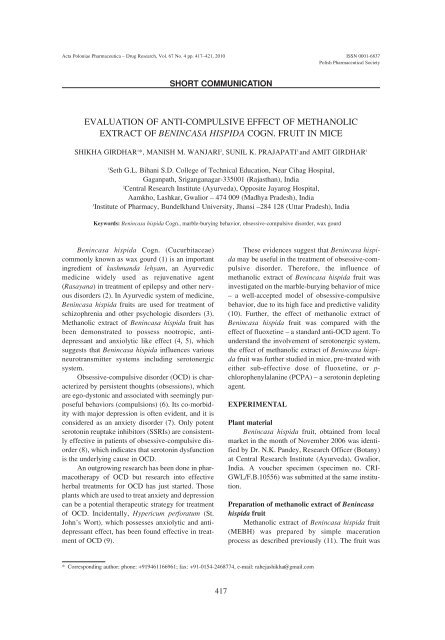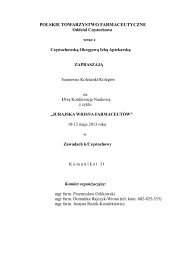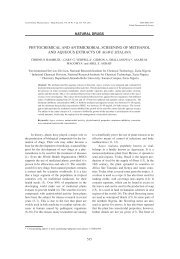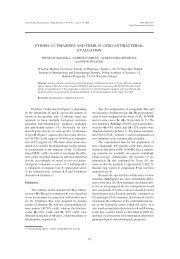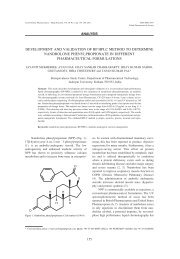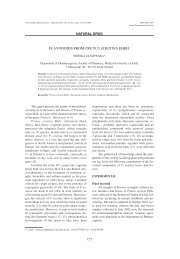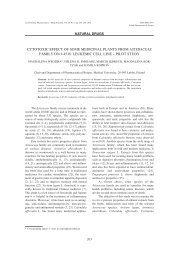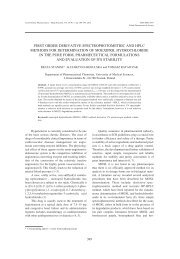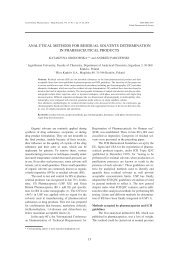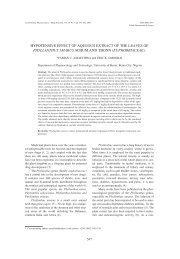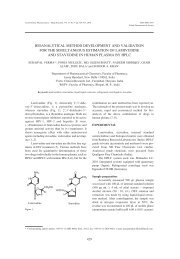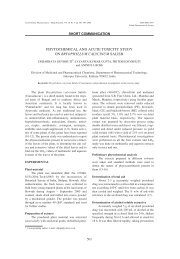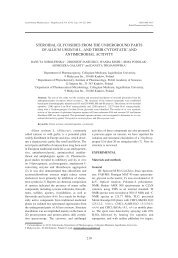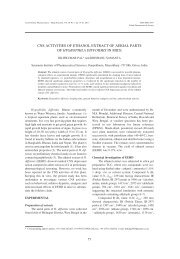Evaluation of anti-compulsive effect of methanolic extract
Evaluation of anti-compulsive effect of methanolic extract
Evaluation of anti-compulsive effect of methanolic extract
Create successful ePaper yourself
Turn your PDF publications into a flip-book with our unique Google optimized e-Paper software.
Acta Poloniae Pharmaceutica ñ Drug Research, Vol. 67 No. 4 pp. 417ñ421, 2010 ISSN 0001-6837<br />
Polish Pharmaceutical Society<br />
SHORT COMMUNICATION<br />
EVALUATION OF ANTI-COMPULSIVE EFFECT OF METHANOLIC<br />
EXTRACT OF BENINCASA HISPIDA COGN. FRUIT IN MICE<br />
SHIKHA GIRDHAR 1 *, MANISH M. WANJARI 2 , SUNIL K. PRAJAPATI 3 and AMIT GIRDHAR 1<br />
1<br />
Seth G.L. Bihani S.D. College <strong>of</strong> Technical Education, Near Cihag Hospital,<br />
Gaganpath, Sriganganagar-335001 (Rajasthan), India<br />
2<br />
Central Research Institute (Ayurveda), Opposite Jayarog Hospital,<br />
Aamkho, Lashkar, Gwalior ñ 474 009 (Madhya Pradesh), India<br />
3<br />
Institute <strong>of</strong> Pharmacy, Bundelkhand University, Jhansi ñ284 128 (Uttar Pradesh), India<br />
Keywords: Benincasa hispida Cogn., marble-burying behavior, obsessive-<strong>compulsive</strong> disorder, wax gourd<br />
Benincasa hispida Cogn. (Cucurbitaceae)<br />
commonly known as wax gourd (1) is an important<br />
ingredient <strong>of</strong> kushmanda lehyam, an Ayurvedic<br />
medicine widely used as rejuvenative agent<br />
(Rasayana) in treatment <strong>of</strong> epilepsy and other nervous<br />
disorders (2). In Ayurvedic system <strong>of</strong> medicine,<br />
Benincasa hispida fruits are used for treatment <strong>of</strong><br />
schizophrenia and other psychologic disorders (3).<br />
Methanolic <strong>extract</strong> <strong>of</strong> Benincasa hispida fruit has<br />
been demonstrated to possess nootropic, <strong>anti</strong>depressant<br />
and anxiolytic like <strong>effect</strong> (4, 5), which<br />
suggests that Benincasa hispida influences various<br />
neurotransmitter systems including serotonergic<br />
system.<br />
Obsessive-<strong>compulsive</strong> disorder (OCD) is characterized<br />
by persistent thoughts (obsessions), which<br />
are ego-dystonic and associated with seemingly purposeful<br />
behaviors (compulsions) (6). Its co-morbidity<br />
with major depression is <strong>of</strong>ten evident, and it is<br />
considered as an anxiety disorder (7). Only potent<br />
serotonin reuptake inhibitors (SSRIs) are consistently<br />
<strong>effect</strong>ive in patients <strong>of</strong> obsessive-<strong>compulsive</strong> disorder<br />
(8), which indicates that serotonin dysfunction<br />
is the underlying cause in OCD.<br />
An outgrowing research has been done in pharmacotherapy<br />
<strong>of</strong> OCD but research into <strong>effect</strong>ive<br />
herbal treatments for OCD has just started. Those<br />
plants which are used to treat anxiety and depression<br />
can be a potential therapeutic strategy for treatment<br />
<strong>of</strong> OCD. Incidentally, Hypericum perforatum (St.<br />
Johnís Wort), which possesses anxiolytic and <strong>anti</strong>depressant<br />
<strong>effect</strong>, has been found <strong>effect</strong>ive in treatment<br />
<strong>of</strong> OCD (9).<br />
These evidences suggest that Benincasa hispida<br />
may be useful in the treatment <strong>of</strong> obsessive-<strong>compulsive</strong><br />
disorder. Therefore, the influence <strong>of</strong><br />
<strong>methanolic</strong> <strong>extract</strong> <strong>of</strong> Benincasa hispida fruit was<br />
investigated on the marble-burying behavior <strong>of</strong> mice<br />
ñ a well-accepted model <strong>of</strong> obsessive-<strong>compulsive</strong><br />
behavior, due to its high face and predictive validity<br />
(10). Further, the <strong>effect</strong> <strong>of</strong> <strong>methanolic</strong> <strong>extract</strong> <strong>of</strong><br />
Benincasa hispida fruit was compared with the<br />
<strong>effect</strong> <strong>of</strong> fluoxetine ñ a standard <strong>anti</strong>-OCD agent. To<br />
understand the involvement <strong>of</strong> serotonergic system,<br />
the <strong>effect</strong> <strong>of</strong> <strong>methanolic</strong> <strong>extract</strong> <strong>of</strong> Benincasa hispida<br />
fruit was further studied in mice, pre-treated with<br />
either sub-<strong>effect</strong>ive dose <strong>of</strong> fluoxetine, or p-<br />
chlorophenylalanine (PCPA) ñ a serotonin depleting<br />
agent.<br />
EXPERIMENTAL<br />
Plant material<br />
Benincasa hispida fruit, obtained from local<br />
market in the month <strong>of</strong> November 2006 was identified<br />
by Dr. N.K. Pandey, Research Officer (Botany)<br />
at Central Research Institute (Ayurveda), Gwalior,<br />
India. A voucher specimen (specimen no. CRI-<br />
GWL/F.B.10556) was submitted at the same institution.<br />
Preparation <strong>of</strong> <strong>methanolic</strong> <strong>extract</strong> <strong>of</strong> Benincasa<br />
hispida fruit<br />
Methanolic <strong>extract</strong> <strong>of</strong> Benincasa hispida fruit<br />
(MEBH) was prepared by simple maceration<br />
process as described previously (11). The fruit was<br />
* Corresponding author: phone: +919461166961; fax: +91-0154-2468774, e-mail: rahejashikha@gmail.com<br />
417
418 SHIKHA GIRDHAR et al.<br />
peeled <strong>of</strong>f and seeds were removed. Pulp was<br />
mashed using an electric juicer to afford a s<strong>of</strong>t mass<br />
and later on macerated with methanol (1 : 4) for<br />
seven days at room temperature with occasional stirring<br />
daily. On eighth day, the pulp mass was filtered<br />
and the filtrate was heated (below 55 O C) and evaporated<br />
under reduced pressure till a strong brownish<br />
liquid was obtained (yield: 5% w/w). It was then<br />
stored at 2ñ4 O C and protected from direct sunlight.<br />
The phytochemical screening <strong>of</strong> MEBH (12)<br />
revealed the presence <strong>of</strong> proteins, tryptophan,<br />
sterols, volatile oils, glycosides, phenolic compounds<br />
and absence <strong>of</strong> carbohydrates, flavonoids<br />
and alkaloids.<br />
Drugs and chemicals<br />
Fluoxetine HCl (Esteem Pharmaceuticals,<br />
Agra, India), was obtained as gift sample while p-<br />
chlorophenylalanine (PCPA) hydrochloride methyl<br />
ester was purchased from Sigma Aldrich, USA. All<br />
the drugs including MEBH were dissolved in 0.9%<br />
saline for pharmacological studies.<br />
Animals<br />
Male Swiss albino mice (22ñ25 g) were used.<br />
They were housed in groups in polypropylene cages,<br />
under 12 h light/dark cycle and controlled conditions<br />
<strong>of</strong> temperature and humidity (25 ± 2 O C, 55 ±<br />
2%, respectively). They received the standard rodent<br />
chow and water ad libitum. The experiments were<br />
carried between 9.00 to 15.00 h in a noise free room.<br />
The animal studies were approved by Institutional<br />
Animal Ethics Committee constituted for the purpose<br />
<strong>of</strong> control and supervision <strong>of</strong> experiments on<br />
animals.<br />
Treatments<br />
Mice were divided into different groups (n =<br />
6). MEBH (200, 400, 600 mg/kg) or fluoxetine (5,<br />
10, 15 mg/kg) or sub-<strong>effect</strong>ive dose <strong>of</strong> MEBH and<br />
fluoxetine were administered intraperitoneally (ip)<br />
30 min prior to the assessment <strong>of</strong> marble-burying<br />
behavior and locomotor activity. The control group<br />
received 0.9% saline (10 mL/kg, ip). After 30 min,<br />
the marble-burying behavior and motor activity<br />
were assessed in separate groups.<br />
In another set <strong>of</strong> experiments, mice were pretreated<br />
with PCPA (300 mg/kg, ip) for 3 consecutive<br />
days and 24 h thereafter MEBH (600 mg/kg, ip) or fluoxetine<br />
(15 mg/kg, ip) were administered. Thirty minutes<br />
thereafter, marble-burying behavior and motor<br />
activity were assessed in separate groups. The doses <strong>of</strong><br />
fluoxetine and MEBH were based on our preliminary<br />
investigations and previous reports (5, 13).<br />
Assessment <strong>of</strong> marble-burying behavior<br />
Marble-burying behavior model was used for<br />
studying the OCD in mice (14). Mice were individually<br />
placed in separate plastic cages (21 ◊ 38 ◊ 14<br />
cm) containing 20 clean glass marbles (10 mm<br />
diameter) evenly spaced on 5 cm deep saw dust.<br />
After 30 min exposure to the marbles, mice were<br />
removed and results were expressed as number <strong>of</strong><br />
marbles buried at least two-third in saw dust.<br />
Assessment <strong>of</strong> motor activity<br />
As OCD is influenced by motor activity, the<br />
same was assessed by using Actophotometer<br />
(Biocraft Scientific Systems Pvt. Ltd., India) with<br />
rectangular arena, and equipped with four photo<br />
cells and receptors. Motor activity was assessed in<br />
terms <strong>of</strong> total number <strong>of</strong> counts <strong>of</strong> light beam interruptions<br />
in 10 min. An acquisition period <strong>of</strong> 5 min<br />
was given to each mouse before assessment <strong>of</strong><br />
motor activity.<br />
Statistical analysis<br />
The data were analyzed by either one-way<br />
ANOVA followed by Newman-Keuls test or twoway<br />
ANOVA followed by Bonferroni test for multiple<br />
comparisons, wherever necessary; p < 0.05 was<br />
considered significant in all cases.<br />
RESULTS<br />
Effect <strong>of</strong> MEBH and fluoxetine on marble-burying<br />
behavior and motor activity<br />
One-way ANOVA exhibited that MEBH significantly<br />
influenced marble-burying behavior [F (3,<br />
20) = 57.76, (p < 0.0001)] (Fig. 1A). The post hoc<br />
test showed that MEBH (400 and 600 mg/kg) significantly<br />
dose dependently (p < 0.001) reduced the<br />
number <strong>of</strong> marbles buried while the lower dose <strong>of</strong><br />
MEBH (200 mg/kg) did not show significant reduction<br />
in the number <strong>of</strong> marbles buried (p > 0.05).<br />
Motor activity was not affected by MEBH (200,<br />
400, 600 mg/kg) [F (3, 20) = 0.36, p = 0.7807] (Fig.<br />
1A).<br />
Similarly, fluoxetine significantly influenced<br />
marble-burying behavior [F (3, 20) = 36.15, p <<br />
0.0001] (Fig. 1B). The post hoc test showed that fluoxetine<br />
(10 and 15 mg/kg) dose dependently<br />
reduced (p < 0.01 and p < 0.001, respectively) marble<br />
burying behavior in mice without any <strong>effect</strong> on<br />
motor activity [F (3, 20) = 0.52, p = 0.6711] while<br />
the lower dose <strong>of</strong> fluoxetine (5 mg/kg) was found<br />
in<strong>effect</strong>ive (p > 0.05) (Fig. 1B).<br />
Further, one-way ANOVA indicated that fluoxetine<br />
and MEBH combined administration in sub-
<strong>Evaluation</strong> <strong>of</strong> <strong>anti</strong>-<strong>compulsive</strong> <strong>effect</strong> <strong>of</strong> <strong>methanolic</strong> <strong>extract</strong> <strong>of</strong> Benincasa hispida Cogn. fruit in mice 419<br />
Figure 1. Influence <strong>of</strong> various drug-treatments on marble-burying behavior and locomotor activity in mice [(A) MEBH, (B) fluoxetine, and<br />
(C) MEBH plus fluoxetine]. Separate groups <strong>of</strong> mice were injected with saline (10 mL/kg, ip) or fluoxetine (5ñ15 mg/kg, ip) or increasing<br />
doses <strong>of</strong> MEBH (200ñ600 mg/kg, ip), and 30 min thereafter, individual mouse was tested for marble-burying behavior and locomotor<br />
activity. For co-administration studies, separate groups <strong>of</strong> mice were injected with saline (10 mL/kg, ip) or fluoxetine (5 mg/kg, ip) and 5<br />
min later either saline (10 mL/kg, ip) or MEBH (200 mg/mouse, ip), and 30 min thereafter, individual mouse was tested for marble-burying<br />
behavior and locomotor activity. Marble-burying behavior and locomotor activity was tested in separate groups <strong>of</strong> mice. Each bar represents<br />
the mean ± SEM <strong>of</strong> data from 6 mice. *p < 0.001 vs. respective saline control and fluoxetine control or MEBH control (one-way<br />
ANOVA followed by NewmanñKeuls post hoc test)<br />
<strong>effect</strong>ive doses had significant [F (3, 20) = 38.50, p<br />
< 0.0001] (Fig. 1C) influence on marble-burying<br />
behavior. The post hoc test showed that co-administration<br />
<strong>of</strong> sub-<strong>effect</strong>ive dose <strong>of</strong> MEBH (200 mg/kg)<br />
and sub-<strong>effect</strong>ive dose <strong>of</strong> fluoxetine (5 mg/kg) significantly<br />
(p < 0.001) attenuated marble-burying<br />
behavior without affecting the motor activity [F (3,<br />
20) = 1.21, p = 0.32] (Fig. 1C).<br />
Effect <strong>of</strong> PCPA pre-treatment on the influence <strong>of</strong><br />
MEBH and fluoxetine on marble-burying behavior<br />
and motor activity<br />
Two-way ANOVA indicated that MEBH and<br />
fluoxetine had significant interaction with PCPA<br />
[PCPA-Drug treatment interaction (F (2, 30) =<br />
44.82, p < 0.0001); PCPA treatment <strong>effect</strong> (F (1, 30)<br />
= 124.7, p < 0.0001) and drug treatment <strong>effect</strong> (F (2,<br />
30) = 139.6, p < 0.0001)] and influenced the marbleburying<br />
behavior. Post hoc test suggested that pretreatment<br />
<strong>of</strong> mice with PCPA partially but significantly<br />
attenuated (p < 0.001) the inhibitory <strong>effect</strong> <strong>of</strong><br />
MEBH, whereas completely eliminated (p < 0.001)<br />
the <strong>effect</strong> <strong>of</strong> fluoxetine on the burying behavior.<br />
PCPA pre-treatment per se did not affect the marbleburying<br />
behavior (p > 0.05) (Fig. 2). All these treatments<br />
did not influence the motor activity [PCPA-<br />
Drug treatment interaction (F (2, 30) = 1.293, p=<br />
0.2893); PCPA treatment (F (1, 30) = 1.988, p =<br />
0.1689) and drug treatment interaction (F (2, 30) =<br />
139.6, p= 0.1003)] (Fig. 2).<br />
DISCUSSION AND CONCLUSION<br />
The results <strong>of</strong> the present investigations<br />
revealed that <strong>methanolic</strong> <strong>extract</strong> <strong>of</strong> Benincasa hispida<br />
fruit exhibited <strong>anti</strong>-<strong>compulsive</strong> <strong>effect</strong> by inhibiting<br />
marble-burying behavior and it was comparable<br />
to that <strong>of</strong> fluoxetine. Effect <strong>of</strong> fluoxetine on marbleburying<br />
behavior is in concordance with the previous<br />
findings (13). Various reports suggested that<br />
marble-burying behavior may be more related to<br />
OCD (15, 16) or the <strong>compulsive</strong> behavior (14, 17,<br />
18) and does not model anxiety.<br />
The <strong>anti</strong>-<strong>compulsive</strong> <strong>effect</strong> <strong>of</strong> MEBH was further<br />
subst<strong>anti</strong>ated by the observation that the sub<strong>effect</strong>ive<br />
dose <strong>of</strong> MEBH potentiated the <strong>effect</strong> <strong>of</strong><br />
sub-<strong>effect</strong>ive dose <strong>of</strong> fluoxetine and exhibited the<br />
significant inhibition <strong>of</strong> marble burying behavior.<br />
This <strong>effect</strong> <strong>of</strong> MEBH to potentiate the action <strong>of</strong> fluoxetine<br />
strongly differentiates it from <strong>anti</strong>-anxiety to<br />
<strong>anti</strong>-OCD drug.<br />
Although the exact mechanism <strong>of</strong> action <strong>of</strong><br />
MEBH to exhibit <strong>anti</strong>-<strong>compulsive</strong> activity was not<br />
elucidated in the present study, it appears the<br />
MEBH acts through its influence on serotonergic<br />
system. The involvement <strong>of</strong> serotonergic system
420 SHIKHA GIRDHAR et al.<br />
Figure 2. Effect <strong>of</strong> PCPA pre-treatment on the <strong>anti</strong>-<strong>compulsive</strong> <strong>effect</strong> <strong>of</strong> fluoxetine and MEBH in mice. Separate groups <strong>of</strong> mice were<br />
injected with PCPA [300 mg/kg, ip (◊3 days)] or saline [10 mL/kg, ip (◊3 days], and 24 h after last dose, saline (10 mL/kg, ip) or fluoxetine<br />
(15 mg/kg, ip) or MEBH (600 mg/kg, ip) were administered, and 30 min thereafter, individual mouse was tested for marble-burying<br />
behavior and locomotor activity. Marble-burying behavior and locomotor activity was tested in separate groups <strong>of</strong> mice. Each bar represents<br />
the mean ± SEM <strong>of</strong> data from 6 mice. *p < 0.001 vs. respective fluoxetine and MEBH control. (Two-way ANOVA followed by<br />
Bonferroni post hoc test)<br />
was subst<strong>anti</strong>ated by the fact that pretreatment <strong>of</strong><br />
mice with PCPA partially and significantly attenuated<br />
the inhibitory <strong>effect</strong> <strong>of</strong> MEBH and completely<br />
eliminated the <strong>effect</strong> <strong>of</strong> fluoxetine on the burying<br />
behavior. However, it is not clear by what mechanism<br />
MEBH influences serotonergic system.<br />
Previous study has shown that Hypericum perforatum<br />
(St. Johnís Wort), which is known to possess<br />
<strong>anti</strong>depressant and anxiolytic action (19, 20), has<br />
showed putative <strong>anti</strong>-obsessive <strong>effect</strong> and it was<br />
speculated the <strong>anti</strong>-obsessive <strong>effect</strong> could be related<br />
to the inhibition <strong>of</strong> 5-HT reuptake by H. perforatum.<br />
Hyperforin was thought to be the major serotonergic<br />
component <strong>of</strong> H. perforatum that contributed to<br />
<strong>effect</strong> <strong>of</strong> H. perforatum on marble burying (9). It is<br />
also possible that MEBH might have influence on<br />
5-HT reuptake.<br />
The preliminary phytochemical studies on<br />
MEBH also revealed the presence <strong>of</strong> tryptophan in<br />
the <strong>extract</strong> (data not shown). Tryptophan is an<br />
important precursor <strong>of</strong> serotonin in the serotonergic<br />
neurons and may be enhancing the biosynthesis <strong>of</strong>
<strong>Evaluation</strong> <strong>of</strong> <strong>anti</strong>-<strong>compulsive</strong> <strong>effect</strong> <strong>of</strong> <strong>methanolic</strong> <strong>extract</strong> <strong>of</strong> Benincasa hispida Cogn. fruit in mice 421<br />
serotonin to facilitate the <strong>anti</strong>-<strong>compulsive</strong> <strong>effect</strong> <strong>of</strong><br />
MEBH.<br />
In conclusion, it is clear that MEBH exhibits<br />
significant <strong>anti</strong>-<strong>compulsive</strong> <strong>effect</strong> in marble-burying<br />
behavior test in mice and the <strong>effect</strong> may be attributed<br />
to enhanced serotonergic function.<br />
REFERENCES<br />
1. Grover J.K., Adiga G., Vats V., Rathi S.S.: J.<br />
Ethnopharmacol. 78, 159 (2001).<br />
2. Vimalavathini R., Kumar A.: Indian J.<br />
Pharmacol. 36, 348 (2004).<br />
3. Sharma P.V.: Medhyadi Varg. in The Dravya<br />
Gun-Vijnana Vegetable Drugs., Sharma PV<br />
Ed., p. 14. Chaukhambha Bharti Academy,<br />
Varanasi 2005.<br />
4. Kumar A., Nirmala V.: Indian J. Pharmacol. 35,<br />
130, (2003).<br />
5. Rukumani R., Nidya I.S.R., Nair S., Kumar A.:<br />
Indian J. Pharmacol. 35, 129 (2003).<br />
6. Rasmussen S.A., Eisen J.L.: Psychiatr. Clin.<br />
North Am. 15, 743 (1992).<br />
7. Bartz J.A., Hollander E.: Prog.<br />
Neuropsychopharmacol. Biol. Psychiatry 30,<br />
338 (2006).<br />
8. El Mansari M., Blier P.: Prog.<br />
Neuropsychopharmacol. Biol. Psychiatry 30,<br />
362 (2006).<br />
9. Skalisz L.L., Beijamini V., Andreatini R.:<br />
Phytother. Res. 18, 399 (2004).<br />
10. Joel D.: Prog. Neuropsychopharmacol. Biol.<br />
Psychiatry 30, 374 (2006).<br />
11. Kumar A., Ramu P.: Indian J. Pharmacol.<br />
34,.365 (2002).<br />
12. Khandelwal K.R.: Preliminary Phytochemical<br />
Screening. in The Practical Pharmacognosy.<br />
p.145, Nirali Prakashan, Pune 2007.<br />
13. Gaikwad U., Bhutada P., Wanjari M., Umathe<br />
S.: Eur. J. Pharmacol. 563, 155 (2007).<br />
14. Njungíe K., Handley S.L.: Pharmacol.<br />
Biochem. Behav. 38, 63 (1991).<br />
15. Broekkamp C.L., Rijk H.W., Joly-Gelouin D.,<br />
Lloyd K.L.: Eur. J. Pharmacol. 126, 223 (1986).<br />
16. Broekkamp C.L., Jenck F.: The relationship<br />
between various animal models <strong>of</strong> anxiety, fearrelated<br />
psychiatric symptoms and response to<br />
serotonergic drugs. in The Behavioral<br />
Pharmacology <strong>of</strong> 5-HT. Bevan P., Cools R.,<br />
Archer T. Eds., p. 321. Erlbaum, Hillsdale<br />
1989.<br />
17. Gyertyan I.: Behav. Pharmacol. 6, 24 (1995).<br />
18. Londei T., Valentini A.M., Leone V.G.: Behav.<br />
Brain Res. 94, 249 (1998).<br />
19. Butterweck V., Wall A., Liefl‰nder-Wulf U.,<br />
Winterh<strong>of</strong>f H., Nahrstedt A.: Pharmacopsychiatry<br />
30, 117 (1997).<br />
20. Bhattacharya S.K., Chakrabarti A., Chatterjee<br />
S.S.: Pharmacopsychiatry 31, 22 (1998).<br />
Received: 21. 09. 2009


